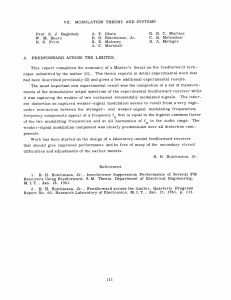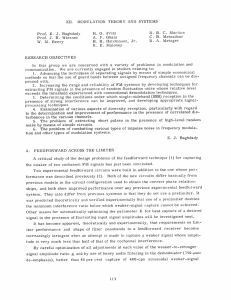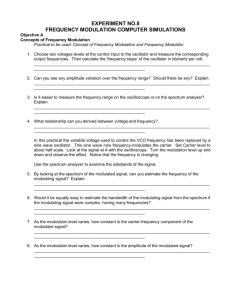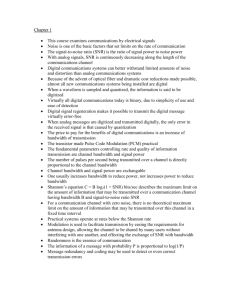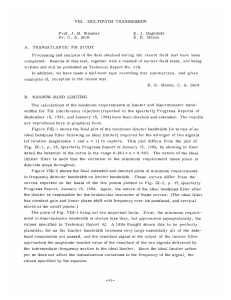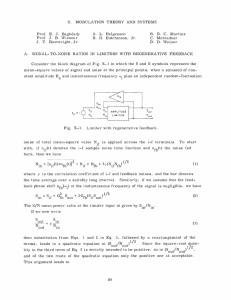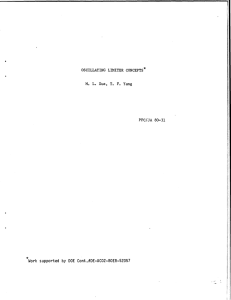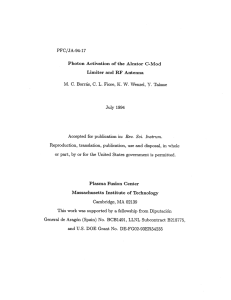XI. MODULATION THEORY AND SYSTEMS
advertisement
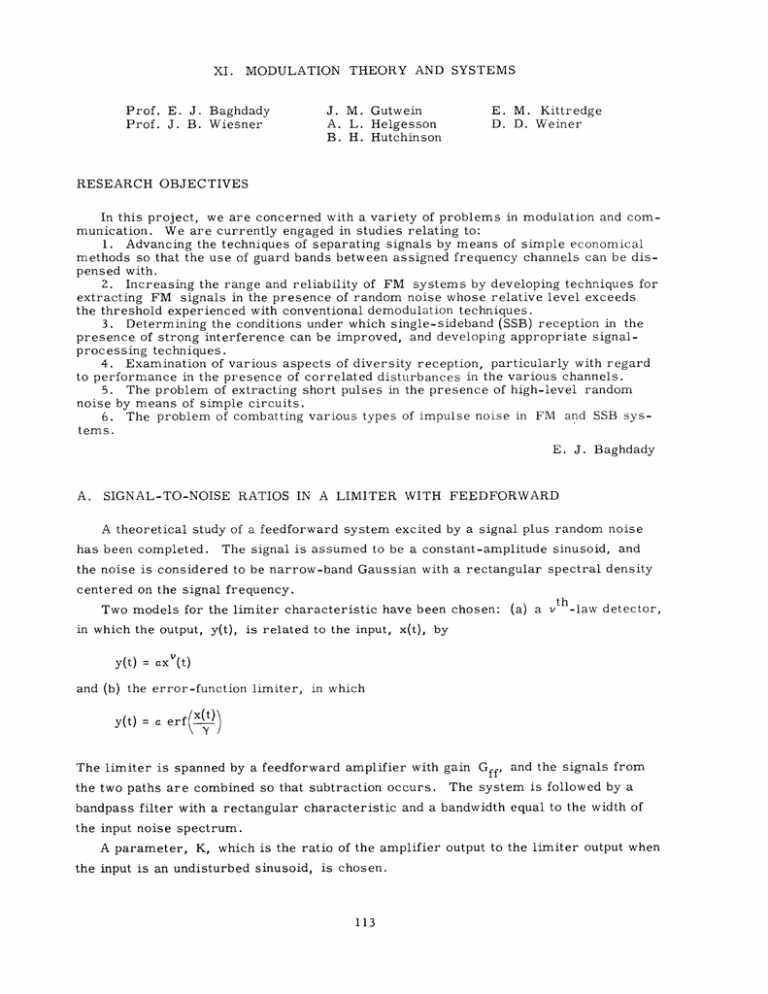
XI. MODULATION Prof. E. J. Baghdady Prof. J. B. Wiesner THEORY AND SYSTEMS J. M. Gutwein A. L. Helgesson B. H. Hutchinson E. M. Kittredge D. D. Weiner RESEARCH OBJECTIVES In this project, we are concerned with a variety of problems in modulation and communication. We are currently engaged in studies relating to: 1. Advancing the techniques of separating signals by means of simple economical methods so that the use of guard bands between assigned frequency channels can be dispensed with. 2. Increasing the range and reliability of FM systems by developing techniques for extracting FM signals in the presence of random noise whose relative level exceeds the threshold experienced with conventional demodulation techniques. 3. Determining the conditions under which single-sideband (SSB) reception in the presence of strong interference can be improved, and developing appropriate signalprocessing techniques. 4. Examination of various aspects of diversity reception, particularly with regard to performance in the presence of correlated disturbances in the various channels. 5. The problem of extracting short pulses in the presence of high-level random noise by means of simple circuits. 6. The problem of combatting various types of impulse noise in FM and SSB systems. E. A. J. Baghdady SIGNAL-TO-NOISE RATIOS IN A LIMITER WITH FEEDFORWARD A theoretical study of a feedforward system excited by a signal plus random noise has been completed. The signal is assumed to be a constant-amplitude sinusoid, and the noise is considered to be narrow-band Gaussian with a rectangular spectral density centered on the signal frequency. Two models for the limiter characteristic have been chosen: in which the output, y(t), (a) a vth-law detector, is related to the input, x(t), by y(t) = axV(t) and (b) the error-function limiter, in which y(t) = a erf x(t) The limiter is spanned by a feedforward amplifier with gain Gff, and the signals from the two paths are combined so that subtraction occurs. The system is followed by a bandpass filter with a rectangular characteristic and a bandwidth equal to the width of the input noise spectrum. A parameter, K, which is the ratio of the amplifier output to the limiter output when the input is an undisturbed sinusoid, is chosen. 113 (XI. MODULATION THEORY AND SYSTEMS) wE G K- EsGff 4a where Es is the amplitude of the input sine wave. Curves of the ratio of the output signal-to-noise mean-power ratio to the input signal-to-noise mean-power ratio as a function of the input signal-to-noise ratio are shown in Fig. XI-1 for the special case of hard limiting; that is, v = 0 or y = 0. The K = 0 curve is for a limiter without feedforward and is very similar to the result obtained by Davenport (1). His computation was based on a wider bandwidth for the output filter than the bandwidth of the input noise. This assumption resulted in a larger noise output than would otherwise be encountered with a filter whose bandwidth equals the i-f bandwidth. 2 a _- 22 (z cz (S/N)IN Fig. XI- 1. Variation of the ratio of output S/N mean-power ratio to input S/N mean-power ratio with the input S/N mean-power ratio for a single narrow-band limiter (K=0), and for a limiter with feedforward (K*0). 114 (XI. MODULATION THEORY AND SYSTEMS) The values of K near -0.5 and -1.0 are of special interest because these are the values for which the feedforward system will suppress the weaker or the stronger of two input sinusoids. The results plotted in Fig. XI-1 show that the reduction of interfering signals by feedforward is accompanied by a degradation in i-f signal-to-randomnoise ratio. A. L. Helgesson References 1. W. B. Davenport, Jr., Signal-to-noise ratios in band-pass limiters, J. Appl. Phys. 24, 720 (1953). 115
